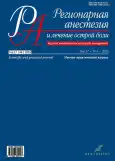Comparison of the analgesic effect of oral morphine with that of intravenous morphine in pediatric patients: multicenter open-label randomized blinded prospective clinical study
- Authors: Belousova E.I.1, Matinyan N.V.1,2, Tsintsadze A.A.1, Kovaleva E.A.1, Valiev T.T.1, Gildeeva G.N.3, Baklykova O.V.4
-
Affiliations:
- Pediatric Oncology and Hematology Research Institute, Blokhin Russian Cancer Research Center
- Pirogov Russian National Research Medical University
- I.M. Sechenov First Moscow State Medical University (Sechenov University)
- Moscow Endocrine Plant
- Issue: Vol 17, No 4 (2023)
- Pages: 243-254
- Section: Original study articles
- Submitted: 21.08.2023
- Accepted: 25.10.2023
- Published: 25.12.2023
- URL: https://rjraap.com/1993-6508/article/view/568648
- DOI: https://doi.org/10.17816/RA568648
- ID: 568648
Cite item
Abstract
BACKGROUND: Certain children with recurrent episodes of acute nociceptive pain experience chronic pain. In accordance with the recommendations of the World Health Organization, short-acting morphine is the main drug used to relieve severe pain and breakthrough pain. In published studies, morphine provided adequate analgesia in the majority (>90%) of the patients; however, no such studies have compared the use of morphine tablets with a control group of pediatric patients.
OBJECTIVE: To evaluate the effectiveness and safety of morphine tablets at a dose of 5 mg and compare them with those of morphine given intravenously at a dose of 10 mg/mL in children with severe pain syndrome in the postoperative period.
MATERIALS AND METHODS: A multicenter open randomized blind prospective clinical study was conducted in parallel groups of 100 patients aged 3–18 years with severe pain syndrome in the postoperative period between September 21, 2020, and December 15, 2022. Cumulative morphine consumption, visual analog scale analgesic efficacy, patient satisfaction scores, and adverse events (AEs) / serious adverse events (SAEs) were assessed.
RESULTS: The comparative analysis of the average values of the total number of doses of an additional analgesic drug administered during treatment with the study drug (group 1)/comparison drug (group 2) in patients of different age groups (cohorts 1, 2, 3) did not reveal significant differences (p=0.05). This finding indicated the equal effectiveness of the used forms of drugs in both groups. Moreover, no significant differences were noted in the development of AEs associated with the study drug (group 1) compared with AEs of the reference drug (group 2) in patients of different age groups (cohorts 1, 2, 3); (p=0.05).
CONCLUSION: The study demonstrated the effectiveness and safety of the study drug in tablets in comparison with an injection drug in children with severe pain syndrome.
Keywords
Full Text
About the authors
Ekaterina I. Belousova
Pediatric Oncology and Hematology Research Institute, Blokhin Russian Cancer Research Center
Email: moyra_526@mail.ru
ORCID iD: 0000-0001-9602-3052
SPIN-code: 8936-8053
Russian Federation, 24 Kashirskoe Rd, 115478, Moscow
Nune V. Matinyan
Pediatric Oncology and Hematology Research Institute, Blokhin Russian Cancer Research Center; Pirogov Russian National Research Medical University
Email: n9031990633@yandex.ru
ORCID iD: 0000-0001-7805-5616
SPIN-code: 9829-6657
MD, Dr. Sci. (Med.), Professor
Russian Federation, Moscow; MoscowAnastasia A. Tsintsadze
Pediatric Oncology and Hematology Research Institute, Blokhin Russian Cancer Research Center
Email: anestesia228@mail.ru
ORCID iD: 0000-0003-1897-0331
SPIN-code: 6513-9338
Russian Federation, Moscow
Ekaterina A. Kovaleva
Pediatric Oncology and Hematology Research Institute, Blokhin Russian Cancer Research Center
Email: Mel_amory@mail.ru
ORCID iD: 0000-0001-9492-034X
SPIN-code: 7122-7508
Russian Federation, Moscow
Timur T. Valiev
Pediatric Oncology and Hematology Research Institute, Blokhin Russian Cancer Research Center
Email: timurvaliev@mail.ru
ORCID iD: 0000-0002-1469-2365
SPIN-code: 9802-8610
MD, Dr. Sci. (Med.)
Russian Federation, MoscowGeliya N. Gildeeva
I.M. Sechenov First Moscow State Medical University (Sechenov University)
Email: gildeeva_g_n@staff.sechenov.ru
ORCID iD: 0000-0002-2537-2850
SPIN-code: 8386-8593
MD, Dr. Sci. (Med.), Professor
Russian Federation, MoscowOksana V. Baklykova
Moscow Endocrine Plant
Author for correspondence.
Email: mez@endopharm.ru
ORCID iD: 0009-0004-8957-1586
Russian Federation, Moscow
References
- Friedrichsdorf SJ, Giordano J, Desai Dakoji K, et al. Chronic Pain in Children and Adolescents: Diagnosis and Treatment of Primary Pain Disorders in Head, Abdomen, Muscles and Joints. Children (Basel). 2016;3(4):42. doi: 10.3390/children3040042
- Rabbitts JA, Zhou C, Groenewald CB, et al. Trajectories of postsurgical pain in children: risk factors and impact of late pain recovery on long-term health outcomes after major surgery. Pain. 2015;156(11):2383–2389. doi: 10.1097/j.pain.0000000000000281
- Kinoshita M, Olsson E, Borys F, Bruschettini M. Opioids for procedural pain in neonates. Cochrane Database Syst Rev. 2023;4(4):CD015056. doi: 10.1002/14651858.CD015056.pub2
- The Association of Pediatric Palliative Medicine Master Formulary. United Kingdom: APPM; 2012.
- WHO Guidelines on the Pharmacological Treatment of Persisting Pain in Children with Medical Illnesses. Geneva: World Health Organization; 2012.
- WHO model list of essential medicines for children — 4th list. Geneva: World Health Organization; 2013.
- Mawatari H, Shinjo T, Morita T, et al. Revision of Pharmacological Treatment Recommendations for Cancer Pain: Clinical Guidelines from the Japanese Society of Palliative Medicine. J Palliat Med. 2022;25(7):1095–1114. doi: 10.1089/jpm.2021.0438
- Harris JT, Suresh Kumar K, Rajagopal MR. Intravenous morphine for rapid control of severe cancer pain. Palliat Med. 2003;17(3):248–256. doi: 10.1191/0269216303pm695oa
- Wiffen PJ, Wee B, Moore RA. Oral morphine for cancer pain. Cochrane Database Syst Rev. 2016;4(4):CD003868. doi: 10.1002/14651858.CD003868.pub4
- Wiffen PJ, Derry S, Moore RA. Impact of morphine, fentanyl, oxycodone or codeine on patient consciousness, appetite and thirst when used to treat cancer pain. Cochrane Database Syst Rev. 2014;2014(5):CD011056. doi: 10.1002/14651858.CD011056.pub2
- Common Terminology Criteria for Adverse Events (CTCAE). Version 5.0. US Department of Health and Human Services; 2017.
- Abuzarova GR, Nevzorova DV, Kumirova EV, et al. Pain management for adults and children when providing medical care. Guidelines. Moscow: FGBOU VO RNIMU im. N.I. Pirogova; 2016. (In Russ).
- Farrar JT, Portenoy RK, Berlin JA, et al. Defining the clinically important difference in pain outcome measures. Pain. 2000;88(3):287–294. doi: 10.1016/S0304-3959(00)00339-0
- Ridgway D, Sopata M, Burneckis A, et al. Clinical efficacy and safety of once-daily dosing of a novel, prolonged-release oral morphine tablet compared with twice-daily dosing of a standard controlled-release morphine tablet in patients with cancer pain: a randomized, double-blind, exploratory crossover study. J Pain Symptom Manage. 2010;39(4):712–720. doi: 10.1016/j.jpainsymman.2009.08.013
- Fortier MA, Chou J, Muarer EL, Kain ZN. Acute to chronic postoperative pain in children: preliminary findings. J Ped Surg. 2011;46(9):1700–1705. doi: 10.1016/j.jpedsurg.2011.03.074
Supplementary files









